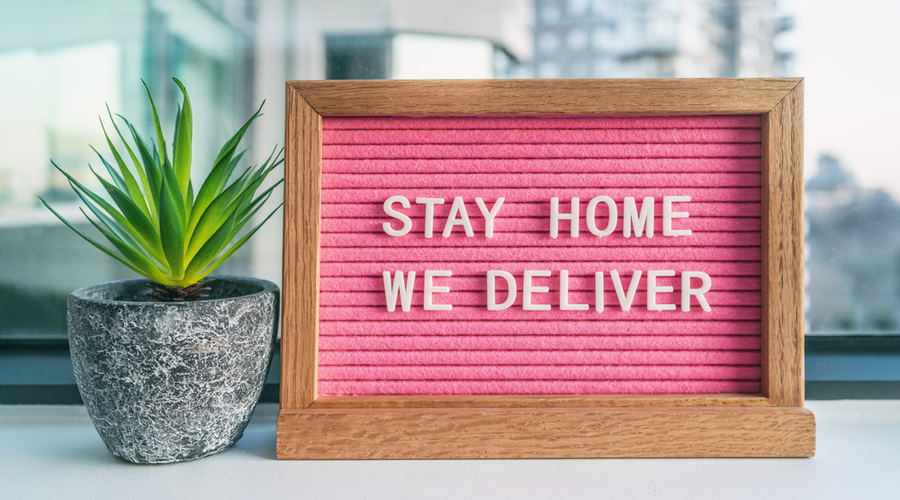Plexiglass shields, masked employees, and social distance markers are now common sites in independent pharmacies across the United States. After the initial frenzy of the coronavirus pandemic in March, many pharmacies have reopened their doors to walk-in patients—and they are discovering new demands and expectations as the virus remains ever-present throughout the country.
“I don’t think I’ve ever written or re-written as many standard operating procedures as I have in the past four or five months,” said Brad White, co-owner and vice president of Medicine Center Pharmacy, which has four locations in Ohio.
The Pharmacy at Wellington in Little Rock, Arkansas, saw their demand for delivery go through the roof overnight. “We had just bought a second car before it really hit, because we had seen the concern in the news coming from overseas,” explained Brittany Sanders, co-owner and pharmacist in charge. Even though the doors of the pharmacy have reopened, that demand remains high.
Dilworth Drug and Wellness Center in Charlotte, North Carolina, has remained closed throughout the summer, continuing to offer pick-up and delivery but not allowing patients inside the store. “We became very transactional, which is really not our business model of health and wellness and care,” said Josh Rimany, founder and chief wellness officer at Dilworth. “That personalized touch is something we’re striving to figure out as this thing becomes chronic.”
Operating three pharmacy locations in Florida, which has become a coronavirus hotspot, Jeff Scott, owner and president of Cheek & Scott Pharmacy, has encountered some unexpected workforce challenges as employees and their family members have contracted the virus. “We’re learning that we can do a few things with fewer people,” he said.
Jasper Drug and Gifts in Jasper, Georgia, never closed its doors, and owner Jack Dunn has worked to become a leader to guide his community through the crisis. He said, “I’m trying to help my community get their feet back on the ground.”
While the coronavirus continues to circulate throughout the US, pharmacies have innovated to keep their businesses profitable and be a reliable destination for patients in turbulent times.
Infection protection
Just because the doors have opened doesn’t mean things have returned to business as usual, and pharmacies are taking unprecedented measures to protect both their patients and employees.
While The Pharmacy at Wellington has technically reopened, they aren’t advertising the fact. “We’re trying to keep traffic in the store low while at the same time recognizing that it is easier for some people who might have a hard time hearing through the drive-thru or want to have a sense of normalcy to come in and have their blood pressure checked, get immunizations, that sort of thing,” Sanders said.
All pharmacies we spoke to had instituted new protection protocols—like wiping down high touch surfaces regularly with disinfectant—and are requiring their employees to wear masks while at work. The fact that PBMs have relaxed regulations about collecting patient signatures has helped employees maintain physical distance.
The highly contagious nature of COVID-19 means that pharmacies are paying extra attention to employees’ health—not just patients. “Our biggest barrier, and what other pharmacies are worried about, are all the what-if scenarios,” Rimany said. “What if an employee tests positive with COVID? Pharmacies can’t quarantine and close for 14 days. It’s impossible. So what do you do if you have one slip-up and COVID hits the pharmacy?”
In the limited space behind the pharmacy counter, it can sometimes be difficult for pharmacists and technicians to maintain the recommended six feet of distance. Besides requiring masks and taking temperatures, Cheek & Scott installed handwashing stations, separated employee and customer bathrooms, and limited the use of shared devices. If any employee has symptoms at all, they are asked to stay home.
At Jasper Drug, staff members have their temperature checked twice a day with infrared thermometers. If there’s a chance one of the employees might be sick, they’re sent home until they can get tested. Dunn is also taking care of employees’ mental health, as working on the front line has understandably jangled some nerves. “I made it mandatory for them to take a walk outside the facility for 15 to 20 minutes when they came back from their lunch break. I wanted them to have a chance to get away from the phone calls and stress.”
Curb is king
Services that allow patients to receive prescriptions and other items without entering the pharmacy continue to be popular even though doors are now open—and curbside pickup has been a particularly big winner.
Since Medicine Center Pharmacy has drive-thru windows, their locations had never offered curbside pickup before, but adding them proved to be a popular choice. While the pharmacies’ doors were still closed, they were even able to recruit local out-of-work bus drivers to help ring patients up and bring products out to the curb so pharmacists and techs could focus on their work behind the counter.
“I definitely want to keep doing curbside pickup,” White said. “Our footprint for the community pharmacies is anywhere from 1200 to 4000 square feet, so we don’t have a long walk to get to the curb.”
The Pharmacy at Wellington also introduced curbside for the first time because of COVID-19. Patients can call ahead and give employees their shopping list, then pick them up at the curb. The service has especially been a boon for over-the-counter and gift items. “We’ll continue to do curbside,” Sanders said. “We’ve had very positive feedback from that. People appreciate not having to get out of the car to get basic things.”
Pre-pandemic, Dilworth Drug did offer curbside pickup, but in a limited fashion. “We had two curbside spots, but they were more or less used for moms who had kids with them and didn’t want to get out of the car,” said Rimany. But without a drive-thru window, curbside has become a necessity, and the pharmacy has expanded to six curbside pickup spots. They’ve integrated the system with a brand new online store, so patients can go online and select what they need with just a couple clicks before they head out to the pharmacy.
Technological Touches
Recommendations for physical distancing have put a damper on the personalized services offered by pharmacies, but the pharmacists we spoke to have found innovative ways to connect with patients using technology.
Jack Dunn has posted videos on social media giving tips on how to strengthen the immune system during COVID-19, and he’s seen them shared far beyond his local community.
As a certified diabetes educator, Jeff Scott had been planning on using the local library to conduct classes before the pandemic, but now the classes will be taught on Zoom. “There were a lot innovations that we were forced into that we now see have a tremendous benefit,” he said. He has also increased his text communications, with around 7,000 patients enrolled in notifications.
For Brad White, technology has been instrumental in building a more cohesive and efficient team. “We’ve gone to weekly Zoom meetings where we’ve talked about current events and new SOPs and best practices, so I really think it’s helped us be a better team and be better informed from top to bottom,” he said. “I’m hoping we can take a lot away from this to improve communication not only with our pharmacy staff but also with our patients, and communicating how we’re keeping them safe and healthy.”
To get back to offering personalized care, Josh Rimany has started offering consultations on Google and Zoom, as well as conducting seminars. “We’re making sure that the content is relevant to them in a medium they can absorb—which is virtual.”
He’s also upped his online presence as a way to meet the desires of patients who are increasingly turning to online retailers like Amazon. “People aren’t wanting to go places, for good reason. It was important for us to have that same mentality, where you could buy online in two clicks and it’s at your door or at the curb, which was a nice touch for us. That was a win.”
Beyond online transactions, Rimany views technology as a means to preserve the essence of his personalized pharmacy during a time that threatens to reverse all the work they’ve done to ditch the dispensing-first model. “If we become transactional for the long haul, it’s going to ruin our business. Pharmacy is not sustainable with just transactions,” he said. “We’re all moving beyond dispensing, and that’s the biggest hurdle, because a lot of us have gone back to just dispensing. And in the next few years, this could really put a hurt on some pharmacies if they aren’t embracing delivering patient care through new mediums like virtual visits or webinars or seminars that are available through a computer.”
New demands
Late March and early April were characterized by a rush of patients trying to get 90-day supplies of all their medications, and after that initial spike, independent pharmacies have seen their prescription volume stabilize. However, many pharmacies we spoke to are still experiencing lower volume than they had pre-COVID, because patients are avoiding the doctor’s office. “People are slowly going back into their routine appointments but it hasn’t completely recovered. We used to have dozens of patients come in from urgent care clinics every day, and that’s just not the same at all,” Sanders said.
Patients are now coming in looking for different kinds of front-end products, with a focus on cleaning supplies, personal protective equipment, and supplements that boost the immune system. “More and more, we’re seeing a need for regular supplies of hand sanitizers, masks, gloves, and other PPE,” White said.
Scott says his over-the-counter sales have doubled or quadrupled, depending on the store, and patients are mostly asking for PPE. “Our city government requires a mask to enter the building, and they send people to us. We’ve got people coming in all day for masks, hand sanitizer, those sorts of things,” he said.
When the outbreak first began, Dunn looked for infrared thermometers, thinking they would be beneficial for doctor’s offices, churches, and schools. To date, he’s sold over 650
infrared thermometers.
Sanders has sold a lot of toilet paper, paper towels, and cleaning supplies, which weren’t typically popular before the pandemic. “It’s really changed the mixture of things we’re selling over the counter,” she said, “and I think that’s here for a while, as people are more aware of cleaning in general and the need to keep things sanitized to prevent the spread of infection.”
Adaptability matters
Between meeting patients’ needs and keeping everyone safe from the still-present COVID-19 threat, pharmacies will have to learn to juggle these priorities for months—if not years—to come.
Scott has found that different patients have vastly different expectations. “You’ve got these two extremes: the people who are really into masks and cleanliness, and the people who are really aggravated with it. Meeting those needs without offending people has become a challenge in the last few weeks.”
While he still hasn’t figured out how to make everybody happy, he says he will continue to prioritize the safety of the staff and stay on top of sanitizing the pharmacy. “I don’t see that ever ending,” he said. “People are looking for places to shop where they can be confident they’re not going to get sick.”
For his part, Dunn is taking the crisis one step at a time. “What’s going to happen? I don’t know. We certainly don’t need to let up, though,” he said.
Sanders recognizes that the increased demand for services like delivery is here to stay, and The Pharmacy at Wellington has added weekend deliveries to meet that demand. They are also making other moves to help patients shop comfortably. Though the pharmacy doesn’t have an e-commerce site, Sanders said, “We encourage people to call, text, or let us know on Facebook, and we’ll get an order ready for them. However they contact us, we’ll figure it out.”
Pharmacies will have to adjust to patients’ new habits, White says, and Medicine Center is catering to different comfort levels by building out their website so patients can order online. They’re also considering expanding their delivery radius to reach people who aren’t currently served by an independent pharmacy.
“I don’t ever want to go through this again, but I will say that we’ve learned a lot about what we were capable of by turning our model on its head to make sure we could still keep the business open in the worst-case scenario,” White said.
Rimany has also seen his store evolve for the better because of the pandemic. “We quickly adopted an online store. That had been something we had been wanting to do, but COVID pushed us to do it quicker,” he said. Going forward, he plans to place a priority on flexibility. “It’s crucial that we are adaptable and that we’re looking outside of the box, not just saying ‘What worked before is going to work tomorrow,’ because that’s not really the case.”
From the Magazine
This article was published in our quarterly print magazine, which covers relevant topics in greater depth featuring leading experts in the industry. Subscribe to receive the quarterly print issue in your mailbox. All registered independent pharmacies in the U.S. are eligible to receive a free subscription.
Read more articles from the September 2020 issue:
- Point of care testing: a cash business opportunity for pharmacy
- The key to a thriving CBD offering
- How to make the most of the cash sitting in your bank
- The ultimate track-and-trace (DSCSA) checklist for pharmacies
- How the pandemic has changed the way independent pharmacies do business
- Attract more shoppers to your pharmacy with one simple device
- How to provide a successful Medicare open enrollment service
- Creating a successful employee schedule: advice from industry experts
An Independently Owned Organization Serving Independent Pharmacies
PBA Health is dedicated to helping independent pharmacies reach their full potential on the buy side of their business. The company is a member-owned organization that serves independent pharmacies with group purchasing services, expert contract negotiations, proprietary purchasing tools, distribution services, and more.
An HDA member, PBA Health operates its own NABP-accredited (formerly VAWD) warehouse with more than 6,000 SKUs, including brands, generics, narcotics CII-CV, cold-storage products, and over-the-counter (OTC) products.
Want more pharmacy business tips and advice? Sign up for our e-newsletter.













